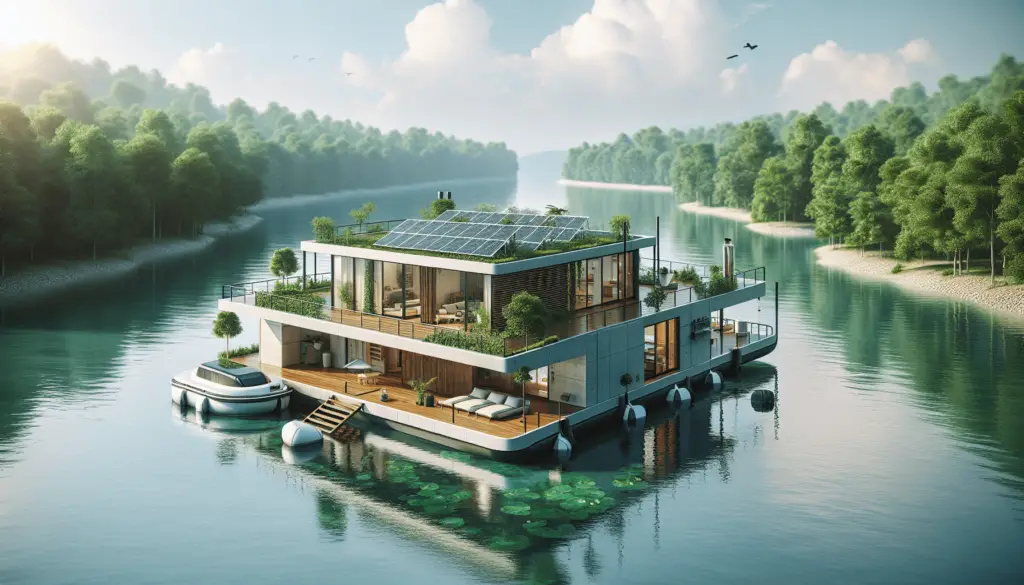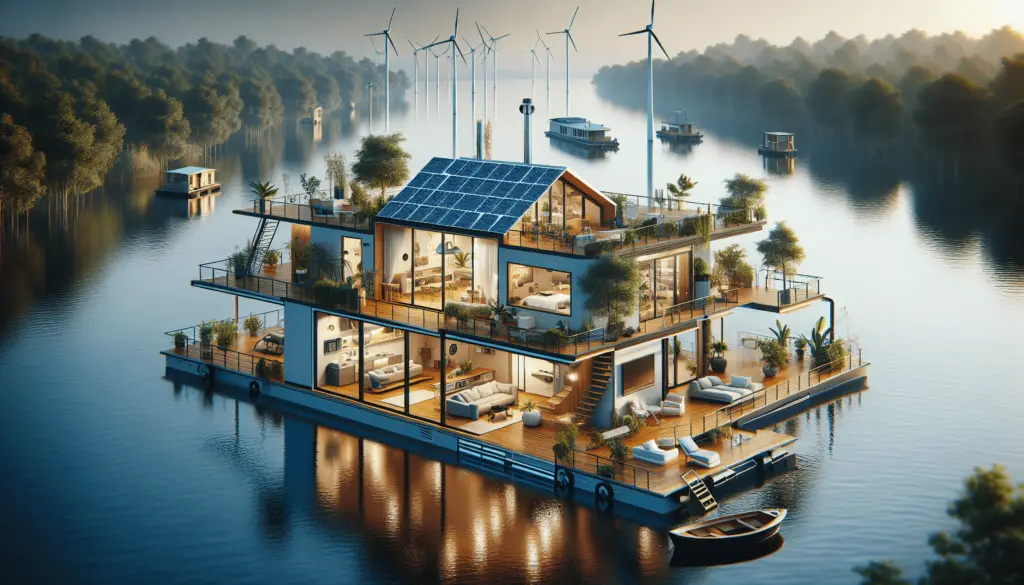Have you ever dreamed of living off the grid, surrounded by nature, with the freedom to move and explore new places? One unique way to achieve this lifestyle is by building a floating off-grid home. In this article, we will discuss various strategies for building and living in a floating off-grid home, from choosing the right location to ensuring sustainability and self-sufficiency. Let’s dive into the world of floating off-grid homes.

Understanding Floating Off-Grid Homes
Floating off-grid homes, also known as houseboats or floating houses, are residences that are not connected to any public utilities such as electricity, water, or sewage systems. Instead, they rely on renewable energy sources like solar power, wind turbines, or water turbines. These homes are usually situated on a body of water, such as a river, lake, or ocean, providing a unique living experience close to nature.
Living in a floating off-grid home allows you to disconnect from the hustle and bustle of city life and embrace a more sustainable and eco-friendly way of living. It offers a sense of freedom and independence, allowing you to live off the land and water while reducing your ecological footprint.
Benefits of Living in a Floating Off-Grid Home
Living in a floating off-grid home comes with a host of benefits, including:
- Connection to Nature: Imagine waking up to the sound of water lapping against your home, surrounded by scenic views of water and wildlife.
- Self-Sufficiency: Building an off-grid home forces you to become more self-sufficient by generating your own energy, collecting rainwater, and managing waste.
- Sustainability: By relying on renewable energy sources, floating off-grid homes are more environmentally friendly and contribute to a more sustainable future.
Living off the grid on water may not be for everyone, but for those seeking a unique and adventurous lifestyle, it can be incredibly rewarding.
Choosing the Right Location for Your Floating Off-Grid Home
The first step in building a floating off-grid home is choosing the right location. Consider the following factors when selecting a location for your floating home:
Water Depth and Currents
Ensure that the water depth is sufficient to support your floating home and that there are no strong currents that could pose a threat. Conduct a thorough survey of the area to determine the water depth and potential risks.
Legal Regulations
Check with local authorities to understand the legal regulations and zoning laws regarding floating homes in your desired location. Some areas may have restrictions on the size, design, or location of floating homes.
Accessibility
Consider the accessibility of your chosen location in terms of transportation, emergency services, and daily necessities. Make sure you can easily reach your floating home and that it is connected to essential services if needed.
Choosing the right location is crucial for the success and sustainability of your floating off-grid home. Take the time to research and visit different areas before making a final decision.
Designing and Building Your Floating Off-Grid Home
Once you have chosen a suitable location for your floating off-grid home, it’s time to start designing and building your dream home. Here are some key factors to consider during the design and construction process:
Sustainable Materials
Opt for sustainable and eco-friendly materials that are durable and resistant to water damage. Consider using recycled or reclaimed materials to reduce your environmental impact and create a unique aesthetic for your home.
Energy-Efficient Design
Design your floating off-grid home with energy efficiency in mind. Incorporate features such as passive solar design, high-quality insulation, and energy-efficient appliances to minimize energy consumption and maximize renewable energy production.
Water Collection and Filtration
Install a rainwater collection system to capture and store rainwater for everyday use. Implement a water filtration system to ensure that the water is safe and clean for drinking, cooking, and bathing.
Waste Management
Develop a comprehensive waste management plan that includes composting, recycling, and proper disposal of waste. Minimize waste production and maximize resource efficiency to create a sustainable living environment.
Designing and building a floating off-grid home requires careful planning and attention to detail. Consult with experienced architects, engineers, and contractors to bring your vision to life.
Off-Grid Systems and Amenities for Your Floating Home
To live comfortably and sustainably in a floating off-grid home, you will need to incorporate various off-grid systems and amenities. Here are some essential systems to consider for your floating home:
Solar Power System
Invest in a solar power system to generate electricity for your floating home. Install solar panels on the roof or deck of your home to capture sunlight and convert it into usable energy. Use a battery storage system to store excess energy for use during cloudy days or at night.
Water Turbine System
If your floating home is situated on a river or other flowing water body, consider installing a water turbine system to generate electricity from the water currents. Connect the turbine to a generator or battery storage system to supplement your energy needs.
Composting Toilet
Opt for a composting toilet system to manage human waste in a sustainable and eco-friendly way. Composting toilets break down waste materials into compost, which can be used as fertilizer for plants. They require little to no water and are odor-free when properly maintained.
Greywater Recycling System
Implement a greywater recycling system to treat and reuse wastewater from sinks, showers, and laundry facilities. Use a filtration and purification system to remove impurities and contaminants from the greywater, making it safe for irrigation or flushing toilets.
By incorporating these off-grid systems and amenities into your floating home, you can enjoy a comfortable and self-sufficient lifestyle while minimizing your impact on the environment.

Enhancing the Sustainability of Your Floating Off-Grid Home
In addition to off-grid systems and amenities, there are several ways to enhance the sustainability of your floating off-grid home. Consider the following strategies to create a more eco-friendly and resilient living environment:
Organic Garden
Create an organic garden on the deck or roof of your floating home to grow fresh fruits, vegetables, and herbs. Use compost from your composting toilet to enrich the soil and reduce the need for chemical fertilizers. Practice companion planting and natural pest control methods to promote a healthy and biodiverse garden.
Marine Habitat Enhancement
Support local marine habitats by incorporating features such as underwater gardens, artificial reefs, or floating wetlands around your floating home. These enhancements can provide shelter and food for aquatic species, improve water quality, and contribute to the overall health of the ecosystem.
Community Engagement
Engage with local communities and organizations to promote environmental stewardship and sustainable living practices. Share your knowledge and experience of living in a floating off-grid home to inspire others to make positive changes in their own lives and communities.
By implementing these sustainability-enhancing strategies, you can create a more resilient and harmonious living environment on your floating off-grid home.
Conclusion
Living in a floating off-grid home offers a unique opportunity to embrace a sustainable and self-sufficient lifestyle surrounded by nature. By choosing the right location, designing and building an eco-friendly home, and incorporating off-grid systems and amenities, you can create a comfortable and resilient living space on the water. Enhance the sustainability of your floating home with organic gardening, marine habitat enhancement, and community engagement to further reduce your ecological footprint and contribute to a more sustainable future. Embrace the adventure of living off the grid on water and enjoy the freedom and independence that comes with it.
